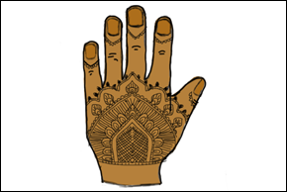Appreciate, don’t appropriate

Growing up, Henna was an important cultural tradition that connected me to a culture 4000 miles away. It’s important that the people who do wear Henna know that it’s more than an aesthetic.
November 4, 2019
Growing up, I loved Saturday mornings. I bounced with excitement every time I watched my mom swirl out the familiar dark brown paste of henna, and I’d stand on my tiptoes to watch her pick out a raw, unbroken piece of spaghetti to help her with the design. A few quick squiggles would turn into intricate mandala patterns, bursting with my mom’s creativity.
More than that, I loved the stories my mom would tell me: how henna covered her arm for her wedding, and how my sister and I would have henna at our weddings in the future. Her stories made me feel connected to a culture 4,000 miles away that I couldn’t find in Bethesda.
Recently, I noticed the familiar brown patterns looping across my friend’s pale, white hand. When I curiously asked her whether she knew the meaning behind henna, I didn’t expect a defensive reaction. But in response to my question, she insisted that she was mindful of Indian culture, and that she had a “pass” by being friends with me.
There’s no such thing as a pass. It’s imperative to understand the difference between taking inspiration from a culture and appropriating a culture. Why did I have to conform when they could cherry-pick the parts of my culture they liked?
Cultural appropriation—when someone takes certain elements from a culture without showing understanding or respect for the culture—marginalizes the people and culture it takes from, allowing dominant ethnic groups to take credit for aspects of a culture they have copied. This issue expands beyond just henna: major fashion brands like Gucci and Dior have faced criticism for having models wear turbans or dreadlocks who have no connection to the cultures that do so. The fashion industry sets trends, and by appropriating cultures in their advertisements, they send a message saying that doing so is okay.
In elementary school, I would occasionally hear things like, “your hand looks so weird,” and “it looks like there’s poop on your hand” when I wore henna to school. But when its popularity skyrocketed, the comments I got completely changed; they went from criticism to “wow, that looks amazing,” and “that’s so pretty.”
I felt ripped-off. These comments changed only when American society deemed henna as “cute” and trend-worthy.
This might seem like cultural appreciation, but did my white peers know what henna meant to Indian culture? Why did I have to conform when they could cherry-pick the parts of my culture they liked?
I’m not here to be a Debbie Downer; I don’t want to say that henna only belongs to me or to throw a ten year long curse on everyone. I want people to understand that henna isn’t just an aesthetic; it has meaning and deep ties to Indian tradition. It’s meant to bestow prosperity on a bride as she makes her journey on to marriage. I want to raise attention for my culture and other cultures that have been similarly appropriated.
And, raise attention I shall. So, let’s all be conscious to avoid stereotypes of different cultures. Be open to diversity, but don’t copy any sacred, serious elements from a culture—especially religion, spirits or symbols. If you do wear something from another culture, pay it the respect it deserves. Research it, and spread awareness and acceptance about the culture to people around you. These steps begin the journey toward respecting another culture and ridding our communities of cultural appropriation.
Now, excuse me, I’m going to go swirl out some dark brown henna paste, get an unbroken, raw spaghetti stick and find my mom. It’s henna time.









Chloe • Aug 12, 2021 at 2:05 pm
Oh my gosh this was so well written! I recently went to my local fair and saw a booth of very talented people doing beautiful henna designs on customers! Im white and I new a little bit of the meaning but I felt like I should know more to have this done on myself. I went up and asked the woman who I was to pay to and asked if it was appropriate for me to get this done on myself. And she was so nice about it and told me that if I knew what part of the culture I was using and if I respected it and not appropriate it then she would be happy to do one for me! I loved reading your story and how your mom did this on her! I bet she is so talented! And I’m so glad I read this because I wasn’t too sure about what I had heard prior! I’ll be sure to do all my research and really appreciate this part of this culture and tell others about the beauty of it as well!
jordan finch • Jun 26, 2021 at 11:51 am
I’m African American and when I first got henna it was at a an event that my dad’s job had held in Birmingham, Alabama. Many South Asians live in Birmingham. My grandma’s neighbors are Indian. A lot of South Asians were at the event so I assumed it was started or hosted by them. I notice my sister and stepmom, who are Hispanic got henna and I wanted to try it too. I got it done by Indian women and I thought it looked absolutely beautiful and it smelled amazing. I recently have been seeing a lot of South Asians get angry at people who aren’t South Asian especially white people for using henna on tiktok. They use it for freckles or non-traditional henna designs. I would be mad too because as a Black person in America I know what it’s like to have my culture appropriated. I’ve been wanting to get henna again but I’m not sure if it would be cultural appropriation. I love and admire South Asian culture. I love Bollywood movies and the music, and traditional clothing and I’ve been wanting to eat Indian food for a while now. I’ve even asked one of my Indian mutuals on instagram if it was okay for me to get henna and she said yes as long as I know the history and cultural significance of it. I’ve done some research and now know it’s use for weddings and birthdays in South Asia, the Middle East, and in Africa. I would love to know if I can get henna and if not I totally respect that.